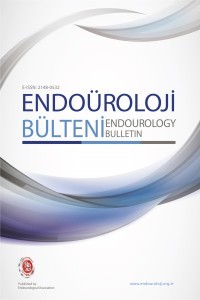COVID-19 pandemisi sırasında üriner sistem taş hastalığının yönetimi: tek merkez deneyimi
COVID-19, endoürolojik taş yönetimi, Üreter taşı, Hidronefroz, Obstruktif Üropati
Management of urinary system stone disease during COVID-19 pandemia: single center experience
COVID-19, endourological stone management, ureter stone, hydronephrosis, obstructive uropathy,
___
- 1. S. Zhao, Q. Lin, J. Ran et al. Preliminary estimation of the basic reproduction number of novel coronavirus (2019-nCoV) in China, from 2019 to 2020: a data-driven analysis in the early phase of the outbreak, Int. J. Infect. Dis. : IJID : Off. Publ. Int. Soc. Infect. Dis. 92 (2020) 214–217
- 2. World Health Organization. Coronavirus disease 2019 (COVID-19) Situation Report – 95. World Health Organization; 2020
- 3. Sağlık Bakanlığı Web sitesi. https://covid19bilgi.saglik.gov.tr/tr/sss/halka-yonelik.html
- 4. Proietti S, Gaboardi F, Giusti G. Endourological Stone Management in the Era of the COVID-19. Eur Urol. 2020 Apr 14. pii: S0302-2838(20)30217-7.
- 5. EAU Guidelines Office Rapid Reaction Group: An organisation-wide collaborative effort to adapt the EAU guidelines recommendations to the COVID-19 era.2020.
- 6. Rosen CL, Brown DF, Sagarin MJ et al. Ultrasonography by emergency physicians in patients with suspected ureteral colic. J Emerg Med 1998;16:865-870.
- 7. EAU Guidelines on urolithiasis. (2019)
- 8. Liu Z, Zhang Y, Wang X et all. Recommendations for Surgery During the Novel Coronavirus (COVID-19) Epidemic. Indian J Surg 2020:1-5.
- 9. Loeffelholz MJ, Tang YW. Laboratory diagnosis of emerging human coronavirus infections - the state of the art. Emerg Microbes Infect 2020, 9(1):747-756.
- 10. Berkow L, Kanowitz A. COVID-19 putting patients at risk of unplanned extubation and airway providers at increased risk of contamination. Anesth Analg 2020.
- 11. Lie SA, Wong SW, Wong LT, Wong TGL, Chong SY. Practical considerations for performing regional anesthesia: lessons learned from the COVID-19 pandemic. Can J Anaesth 2020.
- 12. Gosmanova EO, Baumgarten DA, O’Neill WC. Acute kidney injury in a patient with unilateral ureteral obstruction. Am J Kidney Dis 2009;54: 775–9.
- 13. Ahmad I, Saeed Pansota M, Tariq M, Shahzad Saleem M, Ali Tabassum S. Comparison between Double J (DJ) Ureteral Stenting and Percutaneous Nephrostomy (PCN) in Obstructive Uropathy. Pak J Med Sci. 2013 May;29(3):725-9.
- 14. Novara G, Bartoletti R, Crestani A, De Nunzio C, Durante J, Gregori A. Impact of COVID-19 pandemic on the urologic practice in the emergency departments in Italy. BJU Int. 2020 May 14.
- Yayın Aralığı: 3
- Başlangıç: 2020
- Yayıncı: Pera Yayıncılık
COVID-19 pandemisi sırasında üriner sistem taş hastalığının yönetimi: tek merkez deneyimi
Gökhan ECER, Mehmet Giray SÖNMEZ, İbrahim GÖKSOY, Mert ARSLANER, Hakan TAŞKAPU, Arif AYDIN, Mehmet BALASAR
Thulium Lazer ile Prostat Enükleasyonu(ThuLEP) deneyimleri
Eymen GAZEL, Mehmet YILMAZ, Halil Çağrı AYBAL, Engin KAYA, Serdar YALÇIN, Sercan YILMAZ, Onur AÇIKGÖZ, Lütfi TUNÇ
Endoskopik Kombine İntrarenal Cerrahi
Emre KARABAY, Nejdet KARŞIYAKALI, Kemal KAYAR, Levent VERİM, Çağatay TOSUN, Ömer YÜCEBAŞ
Laparoskopik üreterolitotomi; siz hangi yolu tercih ediyorsunuz?
Arif AYDIN, Gökhan ECER, Muzaffer KILINÇ, Mehmet BALASAR, Nurullah ALTINKAYA, Hakan TAŞKAPU, Mehmet Giray SÖNMEZ
Endoskopik Taş Tedavisinde Gelecekte Bizleri Ne Bekliyor?
Fatih SANDIKÇI, Burhan BAYLAN, Abdurrahim İMAMOĞLU
Retzius Koruyucu Robot Yardımlı Laparoskopik Radikal Prostatektomi
Serkan ALTINOVA, Çağrı GÜNERİ, Muhammet Fuat ÖZCAN
Bahadır TOPUZ, Sercan YILMAZ, Serdar YALÇIN, Sanan ASGARLI, Engin KAYA, Murat ZOR, Mesut GÜRDAL, Selahattin BEDİR
Laparoskopik nefrektomide spesmen çıkarma yönteminin hasta memnuniyetine etkisi
